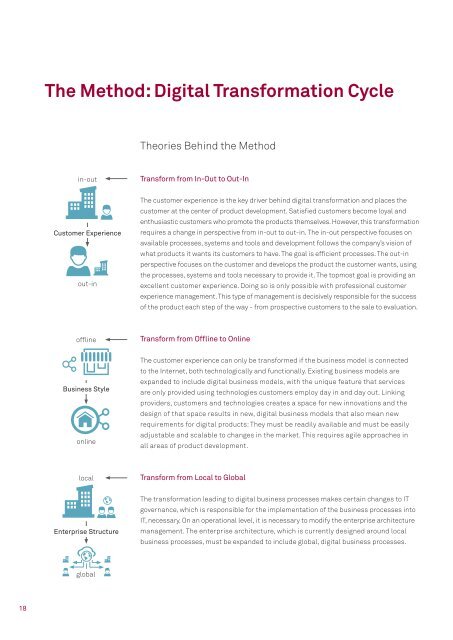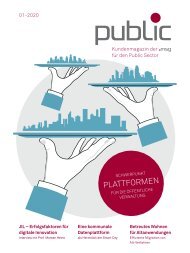Digital Transformation | EN
Operationalization in Practice
Operationalization in Practice
You also want an ePaper? Increase the reach of your titles
YUMPU automatically turns print PDFs into web optimized ePapers that Google loves.
The Method: <strong>Digital</strong> <strong>Transformation</strong> Cycle<br />
Theories Behind the Method<br />
in-out<br />
Transform from In-Out to Out-In<br />
Customer Experience<br />
out-in<br />
The customer experience is the key driver behind digital transformation and places the<br />
customer at the center of product development. Satisfied customers become loyal and<br />
enthusiastic customers who promote the products themselves. However, this transformation<br />
requires a change in perspective from in-out to out-in. The in-out perspective focuses on<br />
available processes, systems and tools and development follows the company’s vision of<br />
what products it wants its customers to have. The goal is efficient processes. The out-in<br />
perspective focuses on the customer and develops the product the customer wants, using<br />
the processes, systems and tools necessary to provide it. The topmost goal is providing an<br />
excellent customer experience. Doing so is only possible with professional customer<br />
experience management. This type of management is decisively responsible for the success<br />
of the product each step of the way - from prospective customers to the sale to evaluation.<br />
offline<br />
Transform from Offline to Online<br />
Business Style<br />
online<br />
The customer experience can only be transformed if the business model is connected<br />
to the Internet, both technologically and functionally. Existing business models are<br />
expanded to include digital business models, with the unique feature that services<br />
are only provided using technologies customers employ day in and day out. Linking<br />
providers, customers and technologies creates a space for new innovations and the<br />
design of that space results in new, digital business models that also mean new<br />
requirements for digital products: They must be readily available and must be easily<br />
adjustable and scalable to changes in the market. This requires agile approaches in<br />
all areas of product development.<br />
local<br />
Transform from Local to Global<br />
Enterprise Structure<br />
The transformation leading to digital business processes makes certain changes to IT<br />
governance, which is responsible for the implementation of the business processes into<br />
IT, necessary. On an operational level, it is necessary to modify the enterprise architecture<br />
management. The enterprise architecture, which is currently designed around local<br />
business processes, must be expanded to include global, digital business processes.<br />
global<br />
18


















